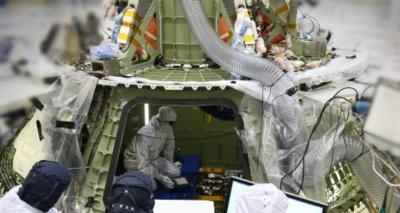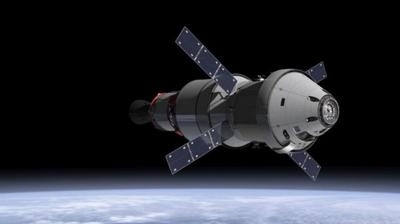Powered On For The First Time As Launch Preps Continue
NASA's first-ever deep space craft, Orion, has been powered on for the first time, marking a major milestone in the final year of preparations for flight.

Orion's avionics system was installed on the crew module and powered up for a series of systems tests at NASA's Kennedy Space Center in Florida last week. Preliminary data indicate Orion's vehicle management computer, as well as its innovative power and data distribution system -- which use state-of-the-art networking capabilities -- performed as expected.
All of Orion's avionics systems will be put to the test during its first mission, Exploration Flight Test-1(EFT-1), targeted to launch in the fall of 2014.
"Orion will take humans farther than we've ever been before, and in just about a year we're going to send the Orion test vehicle into space," said Dan Dumbacher, NASA's deputy associate administrator for exploration systems development in Washington. "The work we're doing now, the momentum we're building, is going to carry us on our first trip to an asteroid and eventually to Mars. No other vehicle currently being built can do that, but Orion will, and EFT-1 is the first step."
Orion provides the United States an entirely new human space exploration capability -- a flexible system that can to launch crew and cargo missions, extend human presence beyond low-Earth orbit, and enable new missions of exploration throughout our solar system.
EFT-1 is a two-orbit, four-hour mission that will send Orion, uncrewed, more than 3,600 miles above the Earth's surface --15 times farther than the International Space Station. During the test, Orion will return to Earth, enduring temperatures of 4,000 degrees Fahrenheit while traveling 20,000 miles per hour, faster than any current spacecraft capable of carrying humans. The data gathered during the flight will inform design decisions, validate existing computer models and guide new approaches to space systems development. The information gathered from this test also will aid in reducing the risks and costs of subsequent Orion flights.

"It’s been an exciting ride so far, but we're really getting to the good part now," said Mark Geyer, Orion program manager. "This is where we start to see the finish line. Our team across the country has been working hard to build the hardware that goes into Orion, and now the vehicle and all our plans are coming to life."
Throughout the past year, custom-designed components have been arriving at Kennedy for installation on the spacecraft -- more than 66,000 parts so far. The crew module portion already has undergone testing to ensure it will withstand the extremes of the space environment. Preparation also continues on the service module and launch abort system that will be integrated next year with the Orion crew module for the flight test.
The completed Orion spacecraft will be installed on a Delta IV heavy rocket for EFT-1. NASA is also developing a new rocket, the Space Launch System, which will power subsequent missions into deep space, beginning with Exploration Mission-1 in 2017.
(Images provided by NASA)
 ANN's Daily Aero-Term (04.25.24): Airport Rotating Beacon
ANN's Daily Aero-Term (04.25.24): Airport Rotating Beacon ANN's Daily Aero-Linx (04.25.24)
ANN's Daily Aero-Linx (04.25.24) Klyde Morris (04.22.24)
Klyde Morris (04.22.24) Airborne 04.24.24: INTEGRAL E, Elixir USA, M700 RVSM
Airborne 04.24.24: INTEGRAL E, Elixir USA, M700 RVSM Airborne 04.22.24: Rotor X Worsens, Airport Fees 4 FNB?, USMC Drone Pilot
Airborne 04.22.24: Rotor X Worsens, Airport Fees 4 FNB?, USMC Drone Pilot




